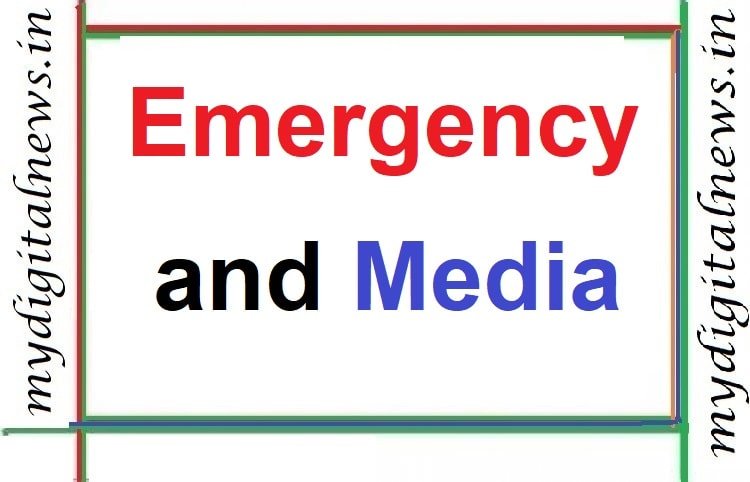Emergency and Media
What is the emergency? Describe the conditions under which emergency maybe clamped in the country. How types of emergencies are specified by the constitution of India? write about the situation that led to claming of emergency in the country on various occasions

Emergency and Media
When the emergency is promulgated along with the common man, the judiciary and the media will have to face hardships and excesses of the emergency. The Constitution, which is the most sacred document of any functioning democracy, can be subverted in the emergency rule.
The fourth estate of democracy i.e. the media will be the first target. Censorship will be imposed on newspapers and no media will have the courage to defy the censorship orders. For the press, the emergency is a cruel reminder that the state can snatch its freedom arbitrarily. Hence, soon after the emergency ended, the Press Council of India was formed whose main aim was to safeguard the freedom of the press and to maintain and improve the standards of newspapers and news agencies in the country.
Few facts may be useful in understanding the enlargement of the power of the state to impose restrictions on the press by reason of proclamation of emergency. On December 3, 1971, a proclamation under art 352 was issued in a view of aggression by Pakistan. While this emergency was continuing a second Proclamation, on the ground of internal disturbance was issued on June 26, 1975.
As a result Article 19 remained suspended by the operation of Article 358 and Orders under art, 359 were also issued by the President barring the right to enforce in the courts the fundamental rights under arts 14, 21 and 22. On January 8, 1976, an order under Art 19 was also issued barring the right to move any court for the enforcement of Art 19. As a result of the foregoing constitutional suspensions consequential upon the Proclamation of Emergency, neither any legislation nor any executive order could be challenged on the ground of violation of Arts 19, 20-22 so that the freedom of the Press and of journalists lay completely at the mercy of the government, without the risk of being challenged in a court of law. Emboldened by this change in the constitutional background, the government of India took the following repressive measures to curb the freedom of the press.
- Issued the Press Censorship Order on June 25, 1975, i.e. immediately after the issue of the Proclamation on the ground of internal disturbance.
- Cancelled the declaration made under the Press and Registration of Books Act, 1867 relating to over 2500 newspapers during the period of operation of the emergency of June 1975 • Detained numerous journalists under the maintenance of internal security (MISA)act or the defence of India rules.
- A specific press law was enacted namely the prevention of objectionable Matter Act, 1976 empowering the government to proceed directly against offending newspapers by way of forfeiture and the like.
- Article 31D was indented in the constitution itself by the 42 nd amendment Act, 1976 giving absolute power to the government to deal with anti-national activities. • All the foregoing repressive measures have been lifted on the eve of or after the coming into power of the Janata Government
- Both the Proclamation of Emergency of 1971 and 1975 was revoked towards the end of March 1977
- The prevention of Publication of Objectionable Matter Act 1976 has been repealed in April 1977
- The censorship order has been revoked on 22.3.1977
- MISA detenues have been released
- • Article 31D of the constitution has been omitted to bypass the constitution (43rd Amendment ) Act, 1977( April 1978) Articles 358 and 359 of the constitution have been amended in 1975 to control their arbitrary use and Art 361A has been inserted in order to give better protection to the reports of proceedings of the legislature.
The Indian Constitution contains Emergency and Special Provisions also. Special Provisions relating to certain clauses are included in Part XVI. Emergency Provisions are placed in Part XVIII of the constitution. Whenever the government declares the state of emergency fundamental rights gets automatically suspended. Even the courts also cannot enforce them. While drafting the constitution this provision was very vehemently and bitterly opposed in the constituent assembly because the fundamental rights also will be in a state of jeopardy and people become helpless on many occasions like arrests without justified cause.
The rights are suspended when the people are arrested under the Preventive Detention Act, which empowers the state to arrest a person for his being a danger to the security of the state. The Emergency Provisions start from Article 352 to Article 360 of the Indian Constitution. Due to external intrusion or war, the President of India can declare a state of emergency through a Proclamation. It can be revoked or a varied proclamation can also be issued.
The proposal of the Cabinet ministers to issue such a proclamation must be approved by the President. The resolution also should have not less than two-thirds of the members of any of the Parliamentary Houses should be required to pass a resolution. In the state of emergency, governance will be taken up under an altered constitutional setup.
During this period President can overrule many provisions of the constitution, which include fundamental rights and the acts that govern the devolution of powers to the states. Emergencies are of three types such as National emergency, state emergency and financial emergency
What's Your Reaction?









































































